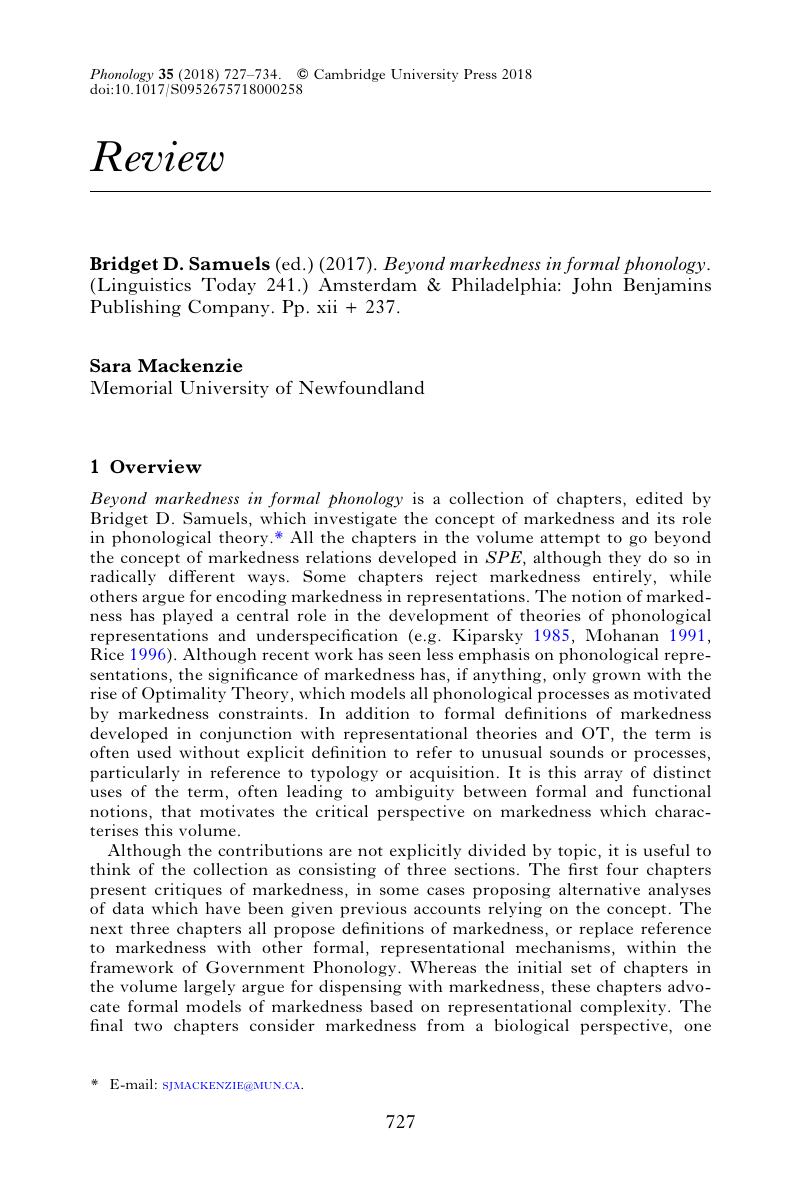No CrossRef data available.
Article contents
Bridget D. Samuels (ed.) (2017). Beyond markedness in formal phonology. (Linguistics Today 241.) Amsterdam & Philadelphia: John Benjamins Publishing Company. Pp. xii + 237.
Review products
Bridget D. Samuels (ed.) (2017). Beyond markedness in formal phonology. (Linguistics Today 241.) Amsterdam & Philadelphia: John Benjamins Publishing Company. Pp. xii + 237.
Published online by Cambridge University Press: 29 November 2018
Abstract
An abstract is not available for this content so a preview has been provided. Please use the Get access link above for information on how to access this content.

- Type
- Review
- Information
- Copyright
- Copyright © Cambridge University Press 2018
References
REFERENCES
Avery, Peter (1996). The representation of voicing contrasts. PhD dissertation, University of Toronto.Google Scholar
de Lacy, Paul (2006). Markedness: reduction and preservation in phonology. Cambridge: Cambridge University Press.Google Scholar
Dresher, B. Elan (2009). The contrastive hierarchy in phonology. Cambridge: Cambridge University Press.Google Scholar
Eulitz, Carsten & Lahiri, Aditi (2004). Neurobiological evidence for abstract phonological representations in the mental lexicon during speech recognition. Journal of Cognitive Neuroscience 16. 577–583.Google Scholar
Flemming, Edward (2004). Contrast and perceptual distinctiveness. In Hayes, Bruce, Kirchner, Robert & Steriade, Donca (eds.) Phonetically based phonology. Cambridge: Cambridge University Press. 232–276.Google Scholar
Gurevich, Naomi (2001). A critique of markedness-based theories in phonology. Studies in the Linguistic Sciences 31:2. 89–114.Google Scholar
Hall, Daniel Currie (2004). A formal approach to /v/: evidence from Czech and Slovak. In Arnaudova, Olga, Browne, Wayles, Rivera, María Luisa & Stojanović, Daniela (eds.) Formal approaches to Slavic linguistics 12: the Ottawa meeting 2003. Ann Arbor: Michigan Slavic Publications. 187–205.Google Scholar
Haspelmath, Martin (2006). Against markedness (and what to replace it with). JL 42. 25–70.Google Scholar
Hayes, Bruce (1984). The phonetics and phonology of Russian voicing assimilation. In Aronoff, Mark & Oehrle, Richard T. (eds.) Language sound structure. Cambridge, Mass.: MIT Press. 318–328.Google Scholar
Hume, Elizabeth (2011). Markedness. In van Oostendorp, Marc, Ewen, Colin J., Hume, Elizabeth & Rice, Keren (eds.) The Blackwell companion to phonology. Malden, Mass.: Wiley-Blackwell. 79–106.Google Scholar
Kiparsky, Paul (1985). Some consequences of Lexical Phonology. Phonology Yearbook 2. 85–138.Google Scholar
Łubowicz, Anna (2003). Contrast preservation in phonological mappings. PhD dissertation, University of Massachusetts, Amherst.Google Scholar
Mielke, Jeff (2008). The emergence of distinctive features. Oxford: Oxford University Press.Google Scholar
Padgett, Jaye (2002). Russian voicing assimilation, final devoicing, and the problem of [v]. Ms, University of California, Santa Cruz. Available as ROA-528 from the Rutgers Optimality Archive.Google Scholar
Rice, Keren (1996). Default variability: the coronal–velar relationship. NLLT 14. 493–543.Google Scholar
Rice, Keren (1999). Featural markedness in phonology: variation. Part 1. Glot International 4:7. 3–6.Google Scholar
Rice, Keren (2007). Markedness in phonology. In de Lacy, Paul (ed.) The Cambridge handbook of phonology. Cambridge: Cambridge University Press. 79–97.Google Scholar
Steriade, Donca (2009). The phonology of perceptibility effects: the P-map and its consequences for constraint organization. In Hanson, Kristin & Inkelas, Sharon (eds.) The nature of the word: studies in honor of Paul Kiparsky. Cambridge, Mass.: MIT Press. 151–179.Google Scholar


